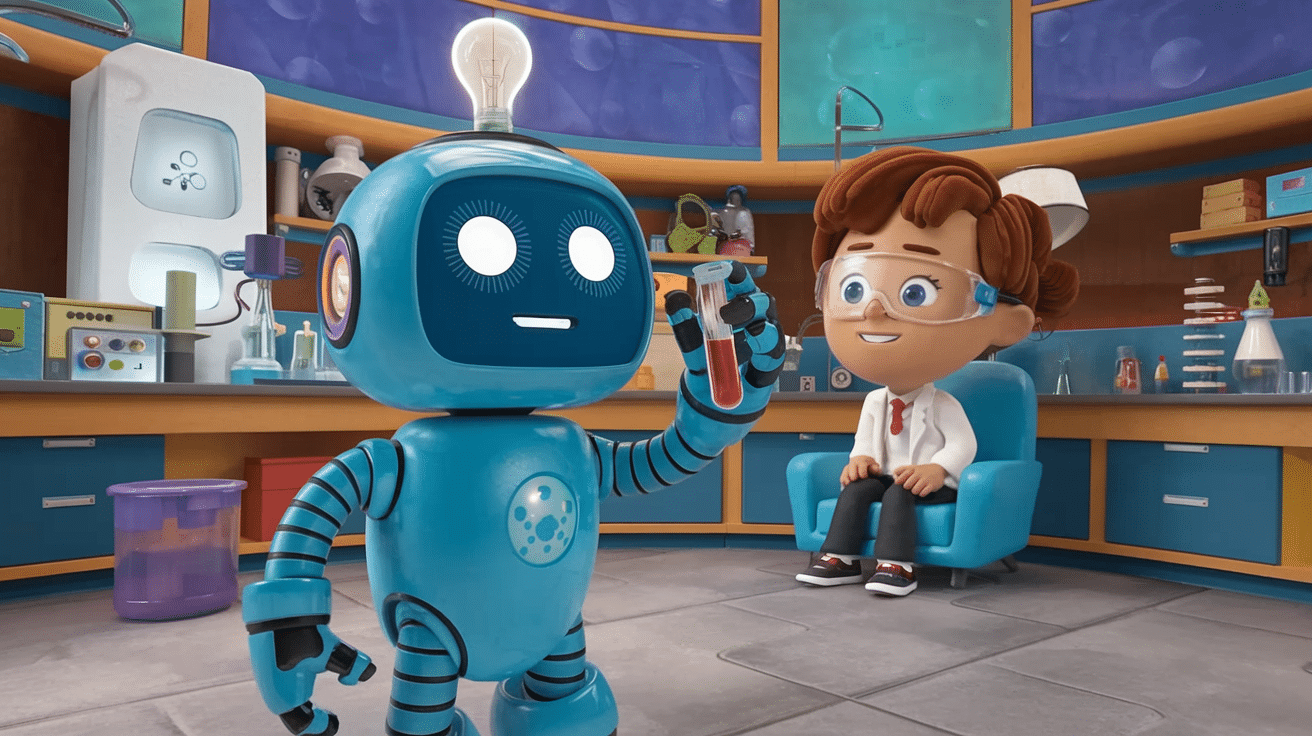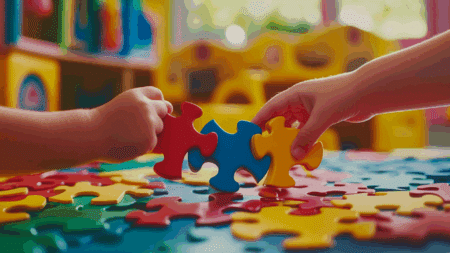Children who love science need shows that spark their interest from a young age. Many parents struggle to find quality programs that teach real scientific concepts while keeping kids engaged and excited.
Good news! There are excellent science shows made just for children that make learning fun without watering down the facts. These programs blend education with entertainment in ways that stick with young viewers.
This article highlights top science shows that can help kids fall in love with chemistry, physics, biology, and more. Each show offers something different – from hands-on experiments to interesting explanations of how our world works.
Ready to find the perfect science shows for your curious little ones? Let’s have a look at the best options available today!
What Makes a Great Science Kid Show for Young Audiences?

Finding science shows that both educate and entertain can be tough. The best programs combine specific elements that make learning stick while keeping children glued to the screen.
Here’s what sets truly good science shows apart from the rest:
1. Clear Explanations: Top science shows break down complex ideas into simple concepts kids can understand. They use basic language and clear examples that connect to a child’s daily life and experiences.
2. Visual Learning: Good shows use bright colors, simple graphics, and slow-motion effects to help kids see scientific processes that might be hard to notice in real life.
3. Hands-on Activities: The most effective shows include experiments that kids can try at home with common household items, turning passive watching into active learning.
4. Relatable Hosts: Hosts who speak directly to young viewers create a personal bond. The best hosts show real excitement about science and make kids feel like valued fellow researchers.
5. Storytelling Format: Children remember facts better when they’re part of a story. Great science shows weave scientific facts into interesting plots with characters kids care about.
When these five elements come together, science shows can turn curious children into lifelong science fans who want to keep asking questions about the world around them.
Classic Science Kid Shows That Inspire Young Minds
Some science shows never go out of style. These classics introduced generations of kids to gravity, biology, and beyond, using humor, fun, and unforgettable characters. In case you’re reminiscing or scouting them for the first time, these shows still hold educational gold.
1. Bill Nye the Science Guy

With his quirky bow tie and infectious energy, Bill Nye made science cool for an entire generation.
The show combined humor, fast-paced editing, and hands-on experiments to make learning a blast. It aired in the 1990s but continues to ignite interest in classrooms and homes today.
Science Secrets to Take Away
Kids will dig deep into physics, chemistry, biology, and more through Bill Nye’s exciting explanations and fun visuals.
The show simplifies complex topics, like gravity, electricity, or the human brain into bite-sized, easy-to-digest episodes. Its use of everyday examples makes science relatable, while Nye’s enthusiasm teaches that asking “why” is just the beginning of revelations.
- Where to watch: Disney+, YouTube
- Ideal Age: 8–12
- IMDB Rating: 8.2
Bill Nye remains a timeless favorite for curious kids ready to question the world. His motto? “Science rules!”
2. The Magic School Bus

Hop aboard the wildest ride in science education with Ms. Frizzle and her class.
Each episode changes an ordinary school day into an extraordinary expedition inside volcanoes, outer space, or the human body. It’s science fiction meets science fact, wrapped in imagination.
Science Secrets to Take Away
The show introduces scientific themes like ecosystems, the solar system, weather patterns, and bodily functions.
Through field trips that defy reality, kids learn how different systems work and interact. The stories often highlight cause and effect, teamwork, and critical thinking, making science both memorable and meaningful.
- Where to watch: Netflix (including “The Magic School Bus Rides Again”)
- Ideal Age: 6–10
- IMDB Rating: 7.8
Even decades later, Ms. Frizzle still reminds kids to “take chances, make mistakes, and get messy!”
3. Beakman’s World

Zany, bold, and bursting with experiments, Beakman’s World delivered science with a dash of chaos.
Host Beakman, along with his crew, tackled viewer questions and performed hilarious experiments to explain scientific concepts. It stood out for its high-energy presentation and colorful set design.
Science Secrets to Take Away
Viewers plunge into mechanics, chemistry, biology, and weather, which is always delivered with clarity and humor. Beakman explains everything from static electricity to digestion using props, demonstrations, and theatrical flair. The show celebrates curiosity and proves that science doesn’t have to be serious to be smart.
- Where to watch: Amazon Prime Video, YouTube
- Ideal Age: 7–12
- IMDB Rating: 8.3
Beakman made science loud, messy, and impossible to ignore, in the best way possible.
4. Sid the Science Kid

With catchy songs and relatable scenarios, Sid the Science Kid encourages preschoolers to observe, question, and examine. Using animation and puppetry, the show focuses on Sid’s day-to-day findings.
It’s a gentle but effective entry into scientific thinking.
Science Secrets to Take Away
The show breaks down basic scientific principles like measurement, change, and cause and effect. It encourages kids to form hypotheses, collect data, and make sense of the world around them. Topics like germs, weather, and machines are made accessible and fun, fostering early STEM literacy.
- Where to watch: PBS Kids, Amazon Prime Video
- Ideal Age: 3–6
- IMDB Rating: 5.5
Sid makes science feel like part of everyday life, because it is!
5. Newton’s Apple

Before the science boom of the 90s, there was Newton’s Apple. It was a thoughtful, educational program that aired on PBS. It tackled real questions from viewers with real scientific answers.
The show featured expert interviews, lab demos, and field reports.
Science Secrets to Take Away
From astronomy to zoology, Newton’s Apple offered an impressive range of topics. Kids learned how volcanoes erupt, why animals migrate, and how engines run.
It encouraged curiosity and treated young viewers like capable thinkers with questions worth exploring.
- Where to watch: YouTube
- Ideal Age: 9–14
- IMDB Rating: 7.9
Newton’s Apple proved that science is about observation, inquiry, and understanding; not just facts.
6. Zoboomafoo

Hosted by the Kratt brothers and a lovable lemur puppet, Zoboomafoo brought wildlife science to life.
The show introduced kids to animal behaviors, habitats, and conservation with a fun, hands-on vibe. Every episode was a playful mix of facts and friendship in the animal kingdom.
Science Secrets to Take Away
Zoboomafoo helps children understand biodiversity, ecosystems, and animal characteristics in an approachable way. From kangaroos to jellyfish, the show dives into how animals adapt and survive. It also touches on themes of environmental care and respect for nature, planting early seeds of conservation awareness.
- Where to watch: PBS Kids, Amazon Prime Video
- Ideal Age: 4–8
- IMDB Rating: 7.6
This wildlife wonderland makes science wild, friendly, and full of fun.
These timeless programs didn’t just explain science, they inspired kids to become scientists. If you’re looking to pass on a little wonder, these classics are the perfect starting point.
Educational Science Kid Shows that Pique Interest
Looking for shows that teach while they entertain? These science series go beyond the basics with engaging experiments, relatable hosts, and surprising facts.
They’re ideal for kids who are constantly asking “Why?”, and for parents who want smart answers.
7. Brainchild

Brainchild blends science with modern curiosity to connect with today’s generation.
Created by Pharrell Williams, the show simplifies science through fun experiments and pop culture references. With upbeat visuals and clear storytelling, it grabs young minds fast.
Science Secrets to Take Away
From social experiments to gravity games, Brainchild dives into neuroscience, emotions, space, and more. The show explains how the brain responds to fear, why we dream, and how germs really spread. It connects science to everyday life, making it easy for kids to relate and remember what they’ve learned.
- Where to watch: Netflix
- Ideal Age: 8–13
- IMDB Rating: 7.5
Brainchild makes science feel personal, and totally cool to understand.
8. SciGirls

SciGirls puts real girls at the center of science, technology, engineering, and math expeditions. The show follows them as they team up to solve real-world problems using STEM skills.
Animated mentor characters help guide each project, making it both inspiring and fun.
Science Secrets to Take Away
Kids learn about renewable energy, coding, robotics, marine biology, and more.
Each episode presents a challenge, like building a sensor or designing a pollution solution, and follows it through experimentation and iteration. The show promotes the scientific method, collaboration, and critical thinking from a girl-empowered perspective.
- Where to watch: PBS Kids, SciGirls.org
- Ideal Age: 8–14
- IMDB Rating: 7.1
SciGirls shows kids they don’t need a lab coat to be scientists; just curiosity and courage.
9. Emily’s Wonder Lab

Emily Calandrelli, a real-life MIT engineer and mom, makes science accessible in this bright, joyful series. She brings big concepts to life using colorful experiments and fun challenges.
Every episode is filled with enthusiasm, sparkles, and hands-on excitement.
Science Secrets to Take Away
From chemical reactions to magnetic fields, kids learn how science is behind the magic of our world. Emily explains things like polymers, inertia, and light energy in ways kids can touch, see, and replicate at home. It’s the perfect mix of learning and play, especially for visual and kinesthetic learners.
- Where to watch: Netflix
- Ideal Age: 6–12
- IMDB Rating: 8.1
Emily proves science can be bubbly, colorful, and seriously fun!
10. Operation Ouch!

This British series features twin doctor-hosts who examine medical science in kid-friendly (and hilarious) ways. They perform gross-out experiments, go behind hospital scenes, and test out body science myths.
It’s weird, wonderful, and surprisingly informative.
Science Secrets to Take Away
The show dives into anatomy, immune responses, and how the human body heals. With actual hospital footage and entertaining experiments, kids learn how bones mend, what blood does, and why we get hiccups. It fosters both curiosity and comfort around health and medical science.
- Where to watch: BBC iPlayer, YouTube
- Ideal Age: 7–13
- IMDB Rating: 8.3
It’s perfect for budding biologists, or any kid who loves a gross-out moment with a smart twist.
11. Ask the StoryBots

The StoryBots are colorful, curious characters who tackle kids’ biggest “why” questions. From “Why is the sky blue?” to “How do computers work?”, this animated show blends humor, music, and celebrity guests.
It’s a visual treat with brainy answers.
Science Secrets to Take Away
Each episode examines one science-heavy question, guiding kids through thoughtful and clear explanations.
The show covers astronomy, mechanics, sound waves, and more, like wrapping facts into catchy songs and creative storytelling. It reinforces learning through repetition and imagination.
- Where to watch: Netflix
- Ideal Age: 4–8
- IMDB Rating: 8.5
StoryBots make asking questions the smartest (and most fun) thing a kid can do.
12. Cosmos: A Spacetime Odyssey

Hosted by astrophysicist Neil deGrasse Tyson, this series is a visually stunning reboot of Carl Sagan’s original.
It takes viewers on a cosmic trip through time, space, and the history of science. Although more advanced, it’s enthralling for older kids and teens.
Science Secrets to Take Away
Cosmos looks into gravity, evolution, black holes, planetary science, and the scientific method. It tells stories of famous findings and forgotten scientists while explaining how we understand the universe today. Its visuals and storytelling inspire awe, imagination, and deeper thinking.
- Where to watch: Disney+, Hulu
- Ideal Age: 12+
- IMDB Rating: 9.3
This series will leave curious minds looking up at the stars with more wonder than ever.
13. MythBusters Jr.

This kid-friendly spinoff of the original MythBusters puts young inventors in the spotlight.
Guided by a seasoned host, the team busts myths using scientific testing and explosive experiments. It’s part entertainment, part engineering boot camp.
Science Secrets to Take Away
Kids learn about hypotheses, variables, and experimentation while testing urban legends and wild questions. The team examines mechanics, physics, and chemistry while building crazy contraptions to prove or bust each myth. It’s hands-on, engaging, and full of STEM inspiration.
- Where to watch: Discovery+, Hulu
- Ideal Age: 9–14
- IMDB Rating: 7.4
MythBusters Jr. shows kids that blowing things up can be safe, if you’re doing science.
From chemistry to coding, these shows turn big ideas into lightbulb moments. With the right spark, your child’s next obsession might just be science.
Fun Science Kid Shows to Watch Together as a Family
Science is even better when it brings the whole family together. These shows combine entertainment and education, offering laughs, wow moments, and plenty of “Did you know?” conversations. They’re perfect for curious minds of all ages to enjoy side by side.
14. Xploration DIY Sci

Hosted by YouTube star Steve Spangler, Xploration DIY Sci is all about at-home experiments with big wow factor.
It’s a mix of science and spectacle, perfect for parents and kids to recreate in the kitchen or backyard. The show invites viewers to think, test, and get hands-on.
Science Secrets to Take Away
This show teaches the chemistry of color changes, the physics of pressure, and the basics of engineering, all through creative, safe DIY projects. It encourages families to plunge into science using everyday items, promoting resourcefulness and critical thinking. Kids don’t just watch, they want to participate.
- Where to watch: Amazon Prime Video, Tubi
- Ideal Age: 7–14
- IMDB Rating: 8.0
It’s the kind of show that turns family night into science night; spills and all.
15. Weird But True!

Produced by National Geographic Kids, Weird But True! plunges into quirky facts that make you say, “Wait, really?” Siblings Charlie and Kirby Engelman scout weird science, from glow-in-the-dark animals to space junk, with crafts, sketches, and jokes.
It’s educational without feeling like homework.
Science Secrets to Take Away
Each episode connects wild facts to real scientific principles, encouraging kids to question everything. It scouts ecosystems, sustainability, biology, and astronomy in ways that blend humor and awe. Kids get curious about the “why” behind the weird, and parents will learn something too.
- Where to watch: Disney+
- Ideal Age: 6–12
- IMDB Rating: 7.6
Perfect for families who like their science with a dash of fun facts and funky surprises.
16. The Cat in the Hat Knows a Lot About That!

Dr. Seuss’s Cat in the Hat brings his rhyming charm to science education. With Thing One and Thing Two along for the ride, the Cat helps Sally and Nick scout the wonders of the natural world.
It’s a magical mix of storytelling and scientific curiosity.
Science Secrets to Take Away
The show introduces topics like animal habitats, weather, and the human body in a light, accessible way. It sparks early scientific thinking by encouraging observation and wonder. Kids and parents can both appreciate how fun and lyrical learning can be.
- Where to watch: PBS Kids, Netflix
- Ideal Age: 3–7
- IMDB Rating: 6.4
This show proves that a little rhyme can go a long way in making science fun for everyone.
17. Annedroids

Annedroids follows a young girl scientist named Anne who builds androids in her junkyard laboratory. Along with her friends and robot creations, she conducts experiments, solves problems, and pushes boundaries.
It’s techy, imaginative, and full of heart.
Science Secrets to Take Away
The show emphasizes coding, robotics, engineering, and ethical decision-making in science. Anne models perseverance, critical thinking, and creativity, showing that being a scientist means asking tough questions and making cool things. It’s a show that balances STEM with storytelling.
- Where to watch: Amazon Prime Video
- Ideal Age: 6–11
- IMDB Rating: 7.9
Great for families who love robots, teamwork, and inventive problem-solving.
18. Danger Force: Science Club Episodes

While Danger Force is primarily a superhero comedy, select episodes center around wild science experiments. The show’s over-the-top action and humor sneak in educational moments that kids won’t see coming.
It’s a balance of fun, chaos, and learning.
Science Secrets to Take Away
These science-centered episodes highlight concepts like electromagnetism, kinetic energy, and chemical reactions in a fast-paced, fictional setting.
While the focus is fun first, the science isn’t entirely off base, making it a great conversation starter for deeper learning. Plus, it shows science in unexpected places.
- Where to watch: Paramount+, Nickelodeon
- Ideal Age: 8–13
- IMDB Rating: 3.9
Even superheroes need to know their science, and it’s more fun when the whole family watches together.
19. Dino Dana

This spinoff of Dino Dan follows a curious young girl who imagines dinosaurs in the real world.
Each episode is filled with dino facts, science-based trips, and moments that blend paleontology with creativity. It’s perfect for both dino lovers and future scientists.
Science Secrets to Take Away
The show covers evolutionary science, classification, and natural history through Dana’s scientific journal and observations. It encourages viewers to use logic, observation, and imagination to look into prehistoric creatures and their environments. Parents will appreciate how seamlessly it mixes science with narrative.
- Where to watch: Amazon Prime Video
- Ideal Age: 4–9
- IMDB Rating: 6.6
This one’s a Jurassic-size hit for families with young tourers and future fossil hunters.
20. Nature Cat

A house cat with outdoor dreams, Nature Cat is all about fun and findings.
With his animal friends, he scouts the great outdoors and teaches about nature, ecosystems, and the environment. It’s filled with laughs and learning.
Science Secrets to Take Away
Nature Cat highlights ecological science and earth studies, from plant life to weather cycles. It encourages kids to get outside, observe their surroundings, and understand the natural processes at work. The show turns backyards into science labs for curious minds.
- Where to watch: PBS Kids
- Ideal Age: 5–9
- IMDB Rating: 7.1
It’s a feel-good choice for families who enjoy nature walks, bugs, and backyard science.
21. Ada Twist, Scientist

Based on the beloved book series, Ada is a curious, question-asking third grader with a passion for figuring things out. Along with her friends Iggy and Rosie, she tackles mysteries using science and teamwork.
It’s sweet, funny, and educational.
Science Secrets to Take Away
Ada investigates chemistry, biology, engineering, and more through relatable childhood problems, like smelly socks or broken playground swings. The show reinforces problem-solving, hypothesis testing, and resilience. It shows families that science is all around us if we’re paying attention.
- Where to watch: Netflix
- Ideal Age: 4–8
- IMDB Rating: 7.3
Ada’s charm, brains, and persistence make this a family favorite with substance.
Whether it’s a goofy experiment or a dinosaur expedition, these family-friendly science shows turn screen time into learning time. So grab a snack and press play for a science night at home.
Engaging Ways to Help Your Kids Benefit from Science Shows

Watching science shows can be more than just screen time for your children. With a bit of planning and participation from you, these programs can become powerful learning tools that extend beyond the TV.
Here are six ways to boost what your kids gain from their favorite science shows:
- Watch Together: Sit with your children during the show. Your presence signals that you value the content, and you’ll be ready to answer questions or discuss ideas that come up.
- Ask Open Questions: After the show, ask “Why do you think that happened?” or “What would you change about that experiment?” This helps kids think more deeply about what they saw.
- Try the Experiments: Many science shows feature activities that can be done at home. Set aside time to recreate these with items you already have. The hands-on practice cements the concepts.
- Connect to Daily Life: Point out when you see the show’s science topics in your normal routine. “Remember how we learned about friction on that show? That’s why you need to tie your shoes tight.”
- Visit Related Places: Take trips to museums, nature centers, or planetariums that highlight topics from their favorite shows. These visits make the screen learning three-dimensional.
- Start a Science Journal: Help younger kids draw pictures or assist older ones in writing notes about what they learned. This creates a personal science reference book they’ll be proud of.
By adding these simple steps to your routine, you turn passive viewing into active learning experiences. The shows become starting points for deeper engagement and help build a lasting interest in science that might stay with your children for years to come.
Wrapping It Up
Science shows for kids do more than just fill time; they plant seeds of curiosity that may grow into lifelong passions. By choosing quality programs and watching them actively with your children, you help these seeds take root.
What matters most isn’t how many shows they watch but how the watching connects to real-world learning. Each episode can spark a question, a kitchen experiment, or a trip to the local science museum.
So what’s next? Pick one show from our list and watch it together this week. Ask your child what they think and maybe try a simple experiment based on what you learned. This small step might be the beginning of a wonderful science expedition for your young scientist.
What was your favorite science show as a child? Share in the comments below!




